What to see in Lanzarote and things to do on the island

There are so many wonders that this island offers us that it is essential to have a basic guide to know what to see in Lanzarote and that is our goal today.
Lanzarote is one of those natural paradises offered by the Canary Islands and one of the most important in Spain.
With this guide you will know what to visit in Lanzarote, the activities you can do and the most incredible landscapes you can imagine. Now you can organize your trip so you don’t miss anything.
Index of wonders to see in Lanzarote
What to see in Lanzarote: volcanic landscapes and paradisiacal beaches
The landscape of Lanzarote stands out for its volcanic formations. This essential characteristic makes it unique and gives it an enigmatic air. Its volcanic landscapes often make travelers feel that they are in another world or on another planet.
Traveling through the 850 square kilometers of its geography of lava and sea is like entering a completely new territory.
The island of Lanzarote is witness to the artistic legacy of César Manrique (1919-1992), who turned this volcanic landscape into his most important canvas.
Even with the tourist presence, Lanzarote maintains its aura of an unknown region, especially evident in places like the Timanfaya National Park. Timanfaya National Park.
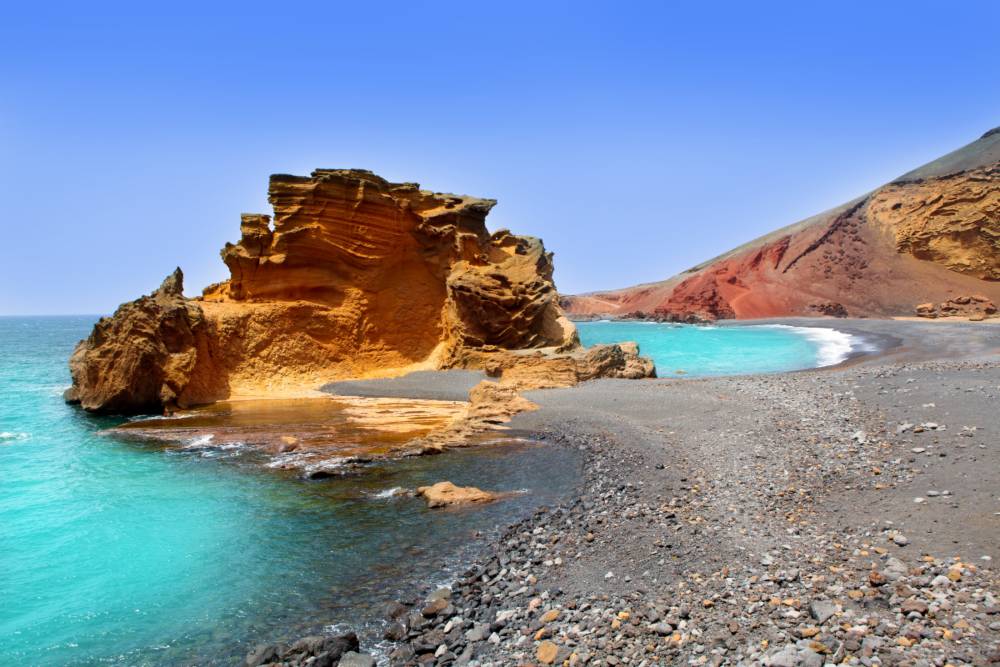
Timanfaya National Park and its volcanic landscapes
Timanfaya National Park is one of the most impressive places to visit in Lanzarote. It is undoubtedly a “must have”, a must that you can not miss if you visit the island.
It is the very definition of volcanic landscape par excellence and one of the iconic images of the island known throughout the world. It is not for nothing that it is commonly known as the “Fire Mountains”.
Among the key aspects you should know about Timanfaya National Park is that it is a protected park of about 50 square kilometers in the west of the island of Lanzarote.
Curiously, it was formed only a few hundred years ago. Specifically in the eighteenth century and more precisely in a series of volcanic eruptions between 1730 and 1736 that completely changed the appearance of this island.
In this period of 6 years several volcanoes covered the area, which originated the landscape that we can see today. Solidified lava fields dotted with craters and a black, red and ocher-colored earth.
The last known volcanic eruption took place in 1824 and finished shaping the area with one of the most incredible landscapes that can be found in Lanzarote and in all the Canary Islands.
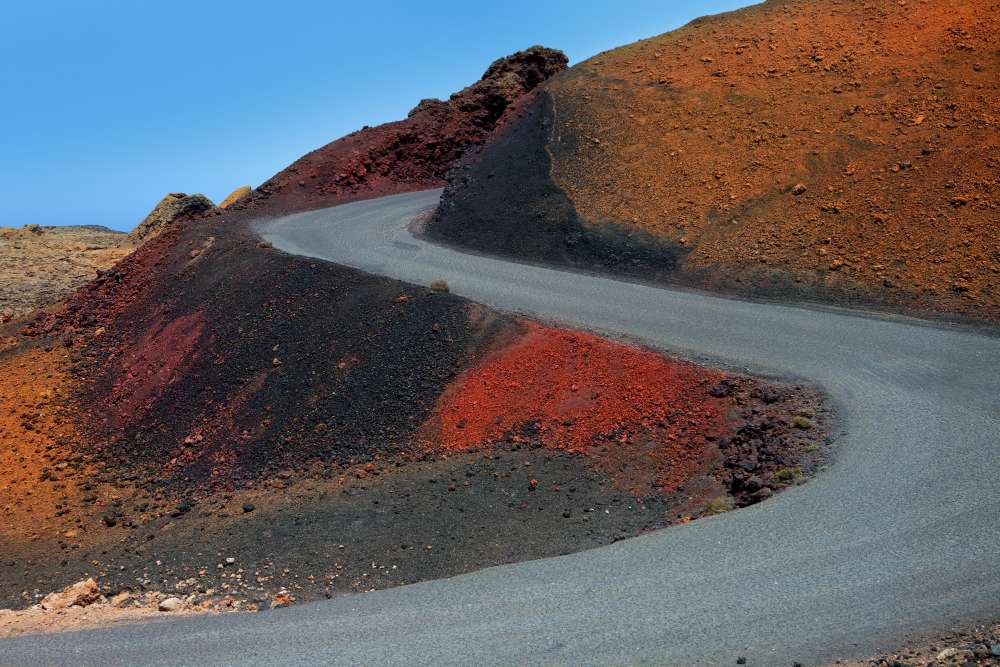
Playa Blanca and its golden sand beaches
The beaches around Playa Blanca, on the island of Lanzarote, are authentic treasures that complement the beauty of this coastal town. From golden sands to crystal clear waters, each beach has its own unique charm.
Let’s take a look at some of the best beaches to see in Lanzarote and enjoy a nice swim in a small paradise.
Flamingo Beach
Located west of the center of Playa Blanca, Playa Flamingo stands out for its fine sand and extensive. Surrounded by hotels. This beach offers breathtaking views with a distinctive palm tree and the majestic Montaña Roja volcano as a backdrop.
With amenities such as showers and restaurants, its accessibility within a few minutes’ walk makes it a convenient and charming option.
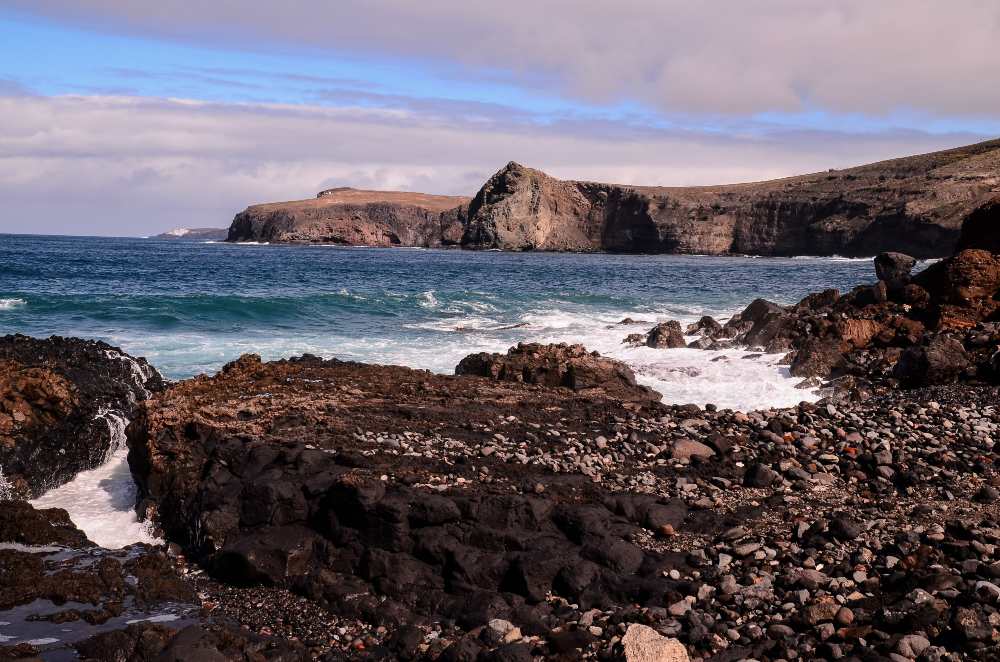
Playa Dorada
In the heart of Playa Blanca, right next to the renowned Yaiza hotel, is Playa Dorada. At 300 meters long, this fine sandy beach is known for its calm waters and cozy atmosphere. With facilities such as showers, bars and restaurants, Playa Dorada offers a relaxing experience in the heart of town.
Playa Blanca
Located on the outskirts of the old town, Playa Blanca is a little gem with a special atmosphere. With its pretty white buildings and central location, this beach offers a charming setting, especially at sunset. With showers available and proximity to the restaurants of the old town, it is a perfect place to enjoy coastal serenity.
Playa Mujeres
Located in the Papagayo wilderness area, Playa Mujeres stands out for its extensive beach of golden sand and turquoise waters. Although it lacks facilities, its natural beauty makes it a popular destination. It can be reached by car or through a pleasant trail from Playa Blanca.
Pozo Beach
Between Playa Mujeres and Playa Papagayo, Playa del Pozo offers a wide expanse of golden sand and rocks. With small dunes at the back, this quiet corner provides shelter from the wind. Although it has no facilities of its own, its natural setting makes it perfect for photography and exploration.
Papagayo Beach
Known as one of the most picturesque beaches of Lanzarote, Playa de Papagayo is located in the wilderness of the south of the island. With its beautiful cove of golden sand and emerald waters, it is sheltered by steep cliffs.
Guarded in high season and with services such as sun lounger rental, it is a charming destination to enjoy the sun and the sea.
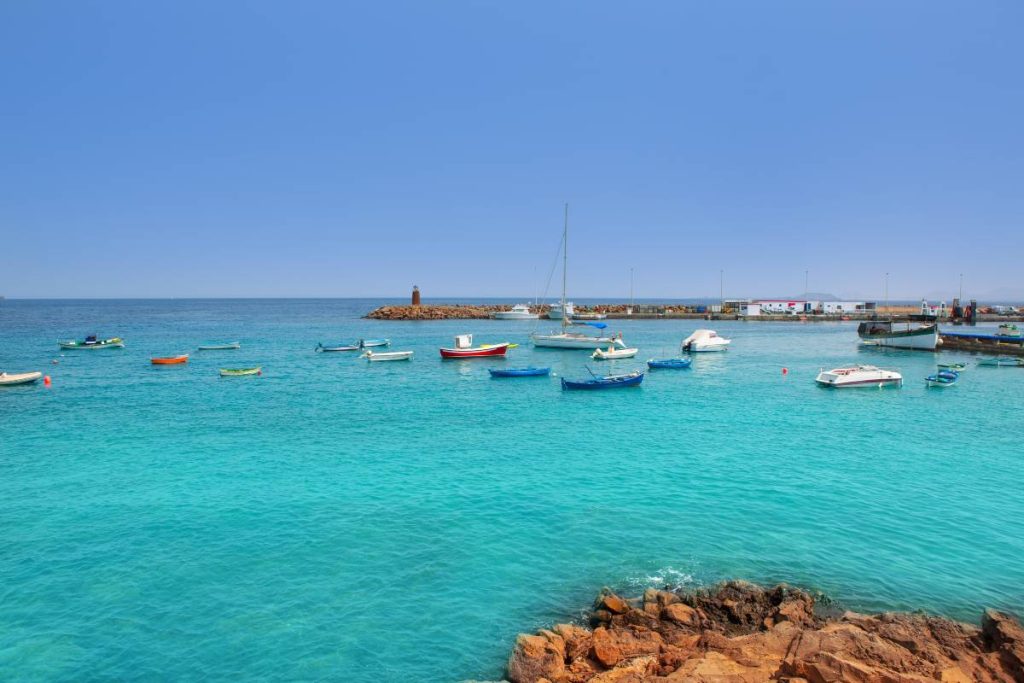
Red Mountain Beach
Located in the western development of Playa Blanca, Playa Montaña Roja offers a fascinating mix of sand and rocks sculpted by the sea. With shades ranging from red to black, this beach invites you to sit and contemplate the natural details. Although it does not have extensive facilities, its unique beauty makes it a memorable place.
Natura Beach
West of the city center, Playa Natura stands out for its mix of golden white sand and gray rocks. Popular with snorkelers, this small beach offers a relaxed atmosphere. With bars and restaurants nearby, it is a lovely place to enjoy the sun and crystal clear waters.
Las Coloradas Beach
Located east of Marina Rubicon, Playa de las Coloradas is unique in the area, being the only beach in the region. With a mixture of sand, gravel and rocks, it offers breathtaking views from the nearby lookout point. Although without guarded services, its uniqueness makes it an interesting visit.
Other wonders to visit in Lanzarote
The Cave of Los Verdes
The Cueva de los Verdes is a unique formation of extraordinary scenic and volcanological value. It is located in the north of the island of Lanzarote, integrated in the vast volcanic landscape of the Malpaís de la Corona. This subway wonder, with a mysterious and special mythological character, reveals its secrets in the bowels of the island and is a “must” to see in Lanzarote yes or yes.
With a length of almost 8 kilometers, the cave is composed of complex tunnels and nooks and crannies adorned with fascinating vaults and internal lagoons. The visible section covers approximately one kilometer of overlapping galleries with vertical connections, reaching heights of up to fifty meters and widths of up to fifteen meters.
Like the Jameos del Agua, the Cueva de los Verdes is part of the volcanic tube created after the eruption of the Corona Volcano, about 4000 years ago. The underwater portion of this tube is known as the Tunnel of Atlantis, standing out as one of the most relevant volcanic tunnels in the world.
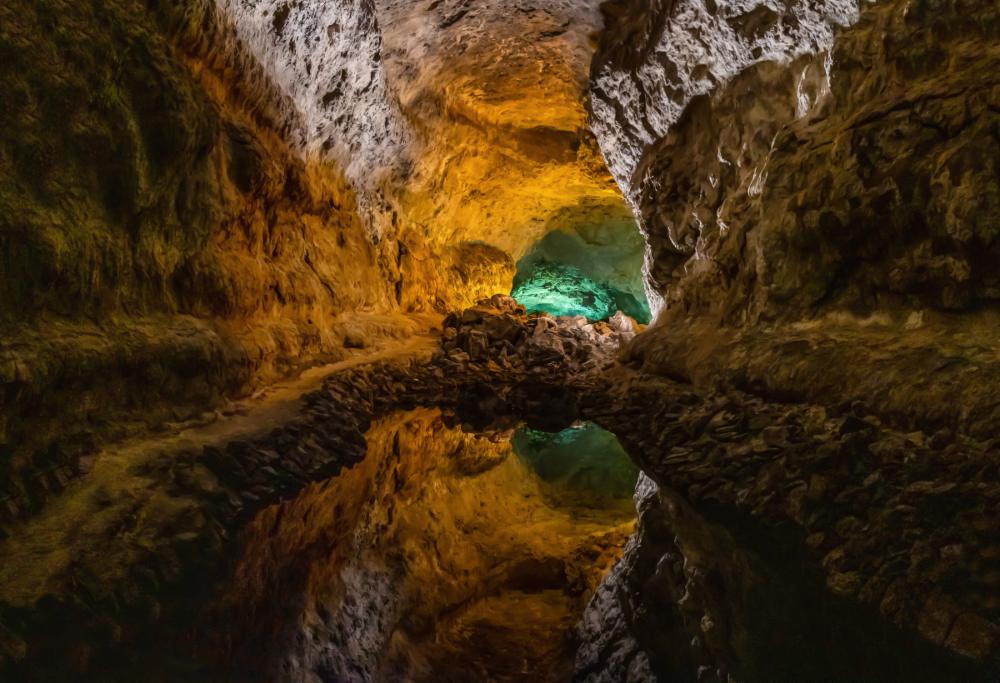
During the XVI and XVII centuries, the cave served as a refuge from the Barbary pirates of North Africa, being named after the surname of a family that used it as a refuge and kept their livestock in the surrounding area.
In the 1960s, Jesús Soto, in collaboration with César Manrique, adapted the cave at the request of the Cabildo of Lanzarote. Preserving the natural surroundings, the only intervention was to condition the path that leads through the cave and to introduce ambient light and sound. These elements, perfectly integrated, create an atmosphere of strange and poetic beauty, making the Cueva de los Verdes an attraction admired by travelers, scholars and scientists from all over the world.

The Jameos del Agua
The Jameos del Agua, an outstanding project by César Manrique, marks the perfect convergence of art, culture and tourism in a unique volcanic tunnel. Its opening in 1968 represented the artist’s vision of fusing artistic creation with the natural harmony of the environment.
Like the Cueva de los Verdes, the Jameos del Agua were formed after the eruption of the Corona Volcano. The word “jameo,” of Guanche origin, refers to the hole resulting from the collapse of the roof of a volcanic tube, in this case, the Corona tube.
César Manrique, with his genius, modeled the basalt, enhancing the beauty of the place and creating a truly unique space. The work was completed in 1977, marking Manrique’s first major intervention in the Lanzarote landscape, with the recognition of Site of Scientific Interest and Cultural Interest in the category of Historic Garden.
The area is composed of three jameos. The Jameo Chico, which serves as access to the interior and the Restaurant, and also has an entrance to the famous Túnel de la Atlántida; the Jameo Grande, which houses the swimming pool; and the Jameo de la Cazuela, located behind the auditorium stage.
The natural auditorium, carved from basalt stone, seats 550 people and provides superb acoustics. The stage is integrated into a section of the volcanic tube, adding unparalleled beauty and sonority, with seating that follows the natural slope of the floor.
The subway aquatic habitat of the Jameos del Agua is impressive, with a crystalline lagoon about 7 meters deep, fed by the filtration of seawater. This volcanic ecosystem is home to some 77 endemic species, with the Blind Crab being the protagonist and symbol of the center.
It is vital to protect this environment; throwing objects or swimming in the lagoon is prohibited, as the endangered Blind Crab is especially vulnerable to metals.
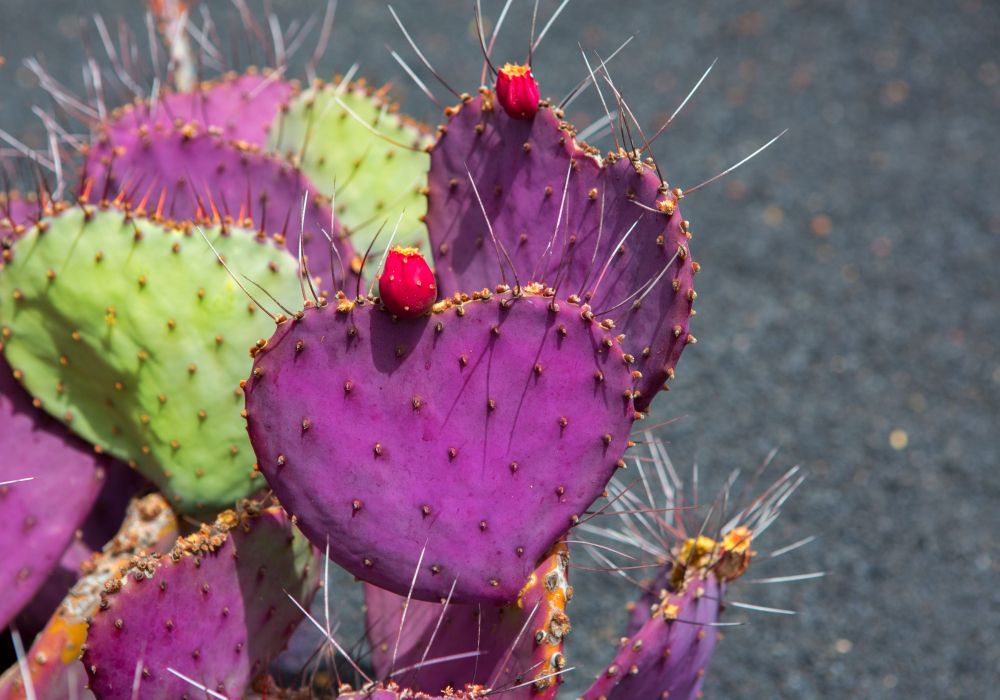
The Cactus Garden
A few minutes from the Jameos del Agua, on the way back to the port of Arrecife, the Cactus Garden in the municipality of Teguise is a must.
With almost fifteen hundred species of cacti from all over the world, this original garden, recognizable by the large metallic cactus at its entrance, is César Manrique’s latest masterpiece on his native island.
One more example of the connection between nature and art that guided his work, especially appreciated by gardening and nature lovers.
The Jameos del Agua and the Cactus Garden are two testimonies of the exceptional creativity of the artist César Manrique. Only 25 minutes drive from the port of Arrecife, the Jameos del Agua impress with their unique integration of nature and art.
Los Jameos volcanic cave
Inside the Jameos, a volcanic cave houses a lake inhabited by a unique species of albino crab.
César Manrique took advantage of this natural environment to create an auditorium where concerts are held, a palm garden and one of the most beautiful pools in the world, currently closed to bathing but open to visitors.
What to see in Arrecife, capital city of Lanzarote
Arrecife, the capital of the island of Lanzarote in the Autonomous Community of the Canary Islands, is located in the southeast of the island at an altitude of 10 meters above sea level.
This place, whose name comes from a reef that characterizes it, has its roots around a salt lagoon called Charco de San Ginés. With an area of 32.95 km² and a population of approximately 55,000 inhabitants, Arrecife plays a vital role as the administrative and commercial center of the island.
The marked seafaring character of the city is constantly intertwined with its historical function as a defensive fortress, in addition to its current role as a service city focused on commercial and mercantile relations.
The topography of Arrecife is remarkably smooth, barely altered by the slopes of a series of mountains on its western boundary. This aspect facilitates the circulation of the jable (fine sand) driven by the trade winds, contributing to the unique charm of the city.
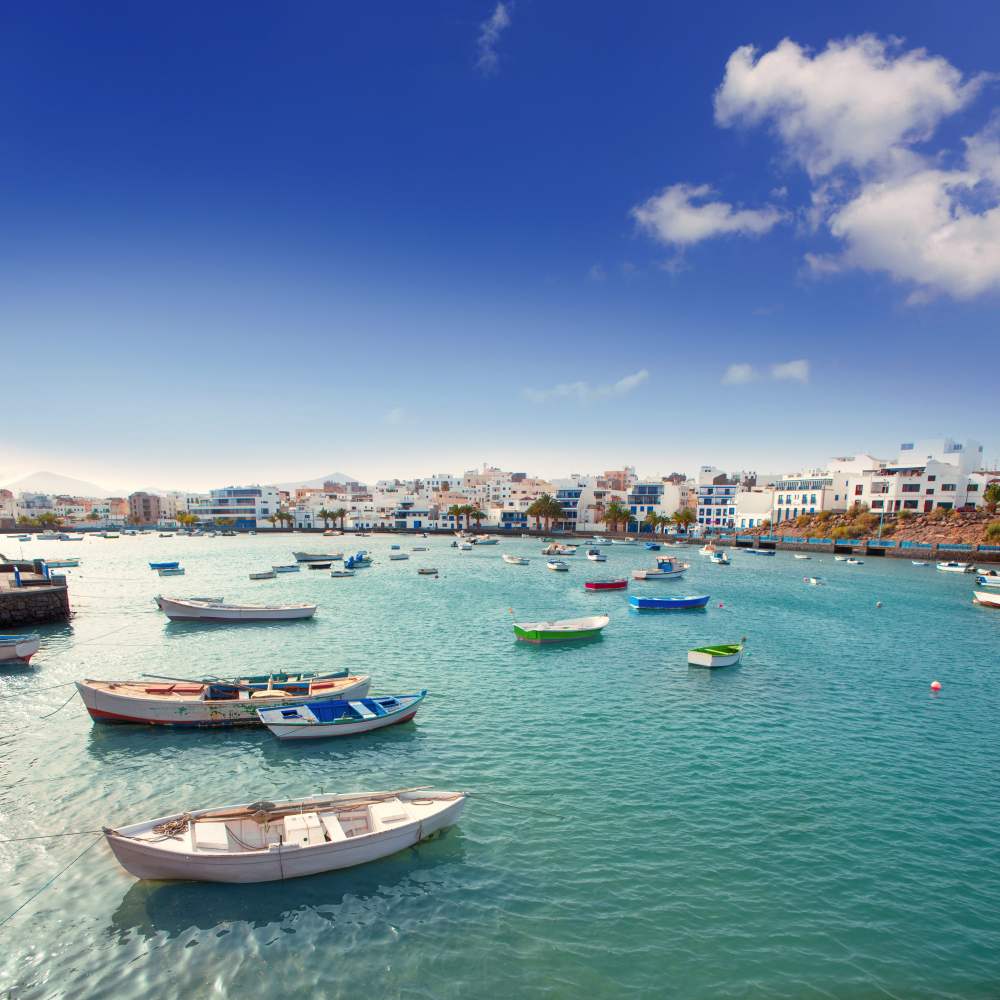
International Museum of Contemporary Art
Here history and art come together. The Castillo de San José is an 18th century fortress that has now been converted into a museum of contemporary art.
The Arrecife International Museum of Contemporary Art stands as an outstanding custodian of a captivating collection that includes works by both national and international artists.
Housed in a space that was once a military fort, the museum offers visitors the opportunity to immerse themselves in the intriguing world of modern and contemporary art.
The museum’s exhibition halls are witness to an eclectic range of artistic expressions, from paintings and sculptures to installations and audiovisual works.
This unique cultural space provides a platform for artistic diversity and innovation, highlighting the creativity of renowned contemporary artists. The museum explores the different forms of visual expression that have left an indelible mark on the artistic landscape.
Mirador and Castillo de San José
The Castillo de San José is a majestic enclave that crowns the capital of Lanzarote. This former military fort has been transformed into the International Museum of Contemporary Art.
A place to immerse yourself in the island’s historic architecture by exploring its art-filled rooms.
From the viewpoint you can enjoy breathtaking panoramic views of Lanzarote and soak in the beauty of the city combined with the nature of the seascape.
Arrecife Food Market
One of the essential places to see in Lanzarote is the Mercado de Abastos de Arrecife. This traditional market stands as the perfect destination to taste and buy fresh and delicious local products.
From freshly caught fish and seafood to island-grown fruits and vegetables, the market offers a high quality culinary variety.
Don’t miss the opportunity to explore the small bars and restaurants inside the market, where you can savor delicious tapas and typical Canarian dishes.
Here you can savor the richness of the local gastronomy while enjoying a memorable experience in the capital of Lanzarote.
Reducto Beach
Reducto beach is the perfect place to relax. An urban beach with Blue Flag that offers an oasis of tranquility. Ideal for families, it has all the necessary services to enjoy a day of sun and sea in the heart of the city.
San Ginés Parish
The parish church of San Ginés is a temple built in 1574 with volcanic stone and wrought iron walls. Its interior is worth seeing with a Mudejar style ceiling and valuable images that narrate centuries of devotion.
The San Ginés puddle
Nor can you miss a visit to the emblematic Charco de San Ginés, a lagoon of volcanic origin that stands as a symbol of the city.
You will be amazed by its sculptures and the impressive whale stranded in 1995, silent witnesses of the cultural and natural richness of Arrecife.
The Yellow House
La Casa Amarilla is a building of Canarian architecture with yellow tiles that houses the Data Center of the Cabildo. A majestic building worth seeing. You can not miss this iconic place and bastion of the history and architecture of the island.
Lanzarote Airport Aeronautical Museum
If you are interested in aeronautical history you can take the opportunity to visit the Aeronautical Museum. You can find it in the old passenger terminal of Lanzarote Airport. Aircraft lovers always end up delighted with this visit.
Guasimeta Beach
This is an extensive beach located between Arrecife and Puerto del Carmen. A perfect place to relax in the sun and marvel at nearby takeoffs and landings from the airport, creating a unique setting for your visit.
The Arroyo’s house
This is another of Lanzarote’s historic sites. La Casa de los Arroyo is a stately building of the eighteenth century with a spectacular central courtyard. Today, it houses different cultural uses that transport you to past times.
What to see in Teguise
Teguise was the historic capital of Lanzarote, it unfolds as a destination steeped in charm and a rich historical narrative.
Nestled among rolling hills, this town offers a unique experience for those seeking to immerse themselves in the authenticity of the island.
Strolling through its cobblestone streets, you will be enveloped in an atmosphere that recalls times past and arouses curiosity to explore its landmarks.
Teguise stands as a treasure full of charm and historical significance, waiting to be discovered in every corner of its cobblestone streets.
Santa Barbara Castle
The Castle of Santa Barbaraa 15th century fortress, towers over Teguise and houses a museum on history and piracy. Although temporarily closed, its strategic location provides a breathtaking view of the volcano caldera and the surrounding area of Teguise.
The Castillo de Santa Barbara, strategically located on a hill, provides not only spectacular panoramic views of Teguise, but also a privileged look at the island’s defensive history.
Touching the stone of its ancient walls will immerse you in another era of history, and will take you back to times of conquests and struggles throughout the centuries.
Our Lady of Guadalupe Church
In Teguise stands out the Church of Nuestra Señora de Guadalupe, a historical monument dating from the 15th century.
You can admire the traditional Canarian architecture of this church, which stands as a testament to the devotion and art of ancient times.
Nearby, the Plaza de la Constitución offers a lively space, surrounded by quaint stores and cozy cafes where you can relax and absorb the essence of the place.
Teguise Market
Finally, you can’t miss the Market of Teguisewhich is held every Sunday.
This lively market is an amalgam of colors, aromas and local flavors. Here you can appreciate and buy fresh produce and all kinds of handicrafts. The market offers an authentic sensory experience that reflects the vitality of the local community.
On Sundays, the Teguise market comes alive with its colorful and cheerful vendors. Although now more touristy, it is still an outstanding attraction, offering pottery, souvenirs, handicrafts and food trucks.
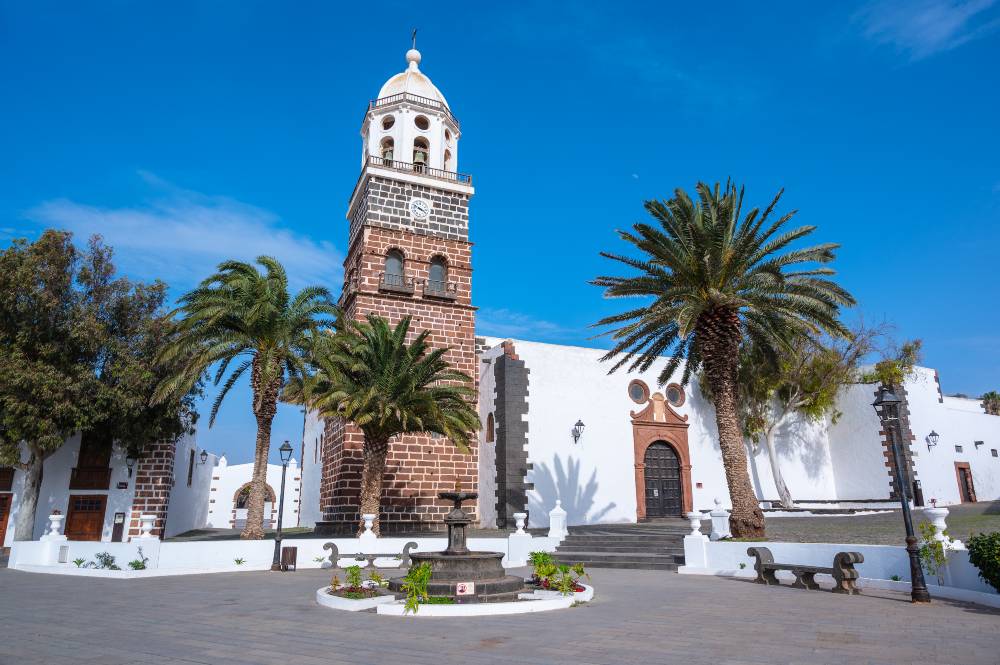
What to visit in Lanzarote: Historic Center of Teguise
The historic center of Teguise is an ancient architectural treasure in Lanzarote. The old town of Teguise is considered a Historic-Artistic Architectural Site and is one of the oldest on the island of Lanzarote.
Its charming cobblestone streets are not only the core of the city, but have also witnessed important episodes in the island’s history.
Undoubtedly, Teguise is positioned as the most beautiful village to explore in Lanzarote, offering a unique perspective between the beaches and the volcanoes. The historic buildings, with their white walls, red bricks, and wooden doors and shutters, add an incomparable charm.
Constitution Square
It is the heart of the town, where the majestic church and its surrounding streets harbor the historical essence of Teguise.
Around this square you can also find numerous places where you can enjoy the local gastronomy in all its extension.
Our Lady of Guadalupe Church
The Iglesia Matriz de Nuestra Señora de Guadalupe, dating back to the 15th century, stands out as a must-see in Teguise. Although its history includes difficult moments, such as looting and fires, the locals have persevered in its reconstruction.
From the outside, the church is distinguished by its red brick tower and bell tower overlooking the city. The tower, square at the base and topped in 1914 to make it the tallest building in the city, is instantly recognizable.
Admire the magnificent entrance door with wood carvings and the surrounding red rocks. Inside, you will discover a spacious church with three naves and side chapels, which houses the most precious ecclesiastical heritage of the island.
The representations, paintings, statues and stained glass windows enrich the experience. The narrow streets of the old town offer more discoveries, with the bell tower as a distinctive guide.
Francisco Torres House
Located on Nueva Street, Casa Torres, built in the 18th century, is a stately home that is well worth a visit.
With its lime walls, dark end stones, carved wooden shuttered windows and beautiful wooden door, the house is a charming example of period architecture.
Its upper part, adorned with typical flowerpots, completes the image. Do not forget to approach the old door to appreciate the ironwork.
Marquis Palace
Known as Casa Palacio Marqués de Herrera, this historic palace from the 16th century, rebuilt in the 17th century by order of Martín de Herrera y Rojas, Marquis of Teguise, is an emblematic testimony of the colonial architecture of the Canary Islands.
Its volcanic stone walls and the inner courtyard surrounded by galleries with wooden balustrades make it a visual landmark. Despite having been burned down in 1618, it has remained unaltered, being one of the oldest buildings in the Canary Islands.
The magnificent wooden door deserves a pause for admiration.
Ico Palace
Located in the cobblestone streets of Teguise, the Palacio Ico, now a charming 9-room hotel, dates back to 1690. Restored and adapted, it retains elements of traditional Canarian architecture.
Its exterior facade presents one of the last wooden balconies in Teguise. Originally known as Casa de los Corneles de Fuerteventura, this building was the residence of the V Governor of the Province of Fuerteventura in the eighteenth century.
From its use as a Civil Guard barracks to a studio and art gallery, the Ico Palace has a rich history.
Timple Museum / Spinola Palace
The Casa Museo Palacio Spínola, renovated in the 1970s by César Manrique and Fernando Higueras, is an 18th century mansion that houses the Timple Museum.
Its original architecture, with white walls and black stones, stands out in the main square. The timple, a typical musical instrument of Lanzarote, is exhibited in the museum, which is open from Monday to Saturday.
Museum of Sacred Art and San Francisco Convent
On the outskirts of the narrow streets of Teguise, the Convent of San Francisco, built at the end of the 16th century, now houses the Museum of Religious Art.
Despite a fire that left only the church, the museum exhibits paintings, jewelry, sculptures and Mudejar tiles. Open Tuesday through Sunday, it offers a glimpse into the artistic and religious richness of the region.
Casa Museo del Campesino
Designed by César Manrique, this tribute to farm workers features buildings with white walls and green borders. The Monumento a la Fecundidad, a 15-meter-high sculpture, stands out in the landscape.
Famara Beach
Just 15 minutes drive from Teguise, Famara beach offers impressive cliffs and is known to be one of the best places to enjoy the sunset in Lanzarote.
LagOmar Museum
A 5-minute drive away, Lagomar is a spectacular private property designed by César Manrique. Built in a quarry with natural tunnels and caves, it has become a fascinating museum.
What to see in Lanzarote Free
Other places to visit for free in Lanzarote
As you stroll through the narrow streets, you will discover buildings with unique stories, such as La Grange, Casa Jiménez, Casa Parroquial, Restaurante Acatife and an old windmill.
Teguise is also home to numerous statues, including the majestic lions in the main square donated by the Spinola family. “Elegua” in front of the convent of San Francisco and “El Tela” by José Aradas García, a bronze sculpture that pays homage to sailors, are other notable works.
The El Golfo lookout point
Through a narrow path, you can access this charming viewpoint, which offers the possibility of visiting for free and at any time of the day the well-known Charco Verde (also called Los Clicos, due to the endemic species that used to submerge in its waters).
The serenity of this lake creates a striking contrast with the choppy waves a few meters away, close to the shore, providing a visual delight.
This viewpoint, located at the starting point of the Jinama royal road, the main pedestrian route to the Gulf Valley, reveals a panoramic view that highlights the difference between the plateau behind us and the rugged laurel forest. A true feast for the senses.
From this high point, you can enjoy a wide view that encompasses the Gulf Valley and the blanket of clouds created by the persistent trade winds.
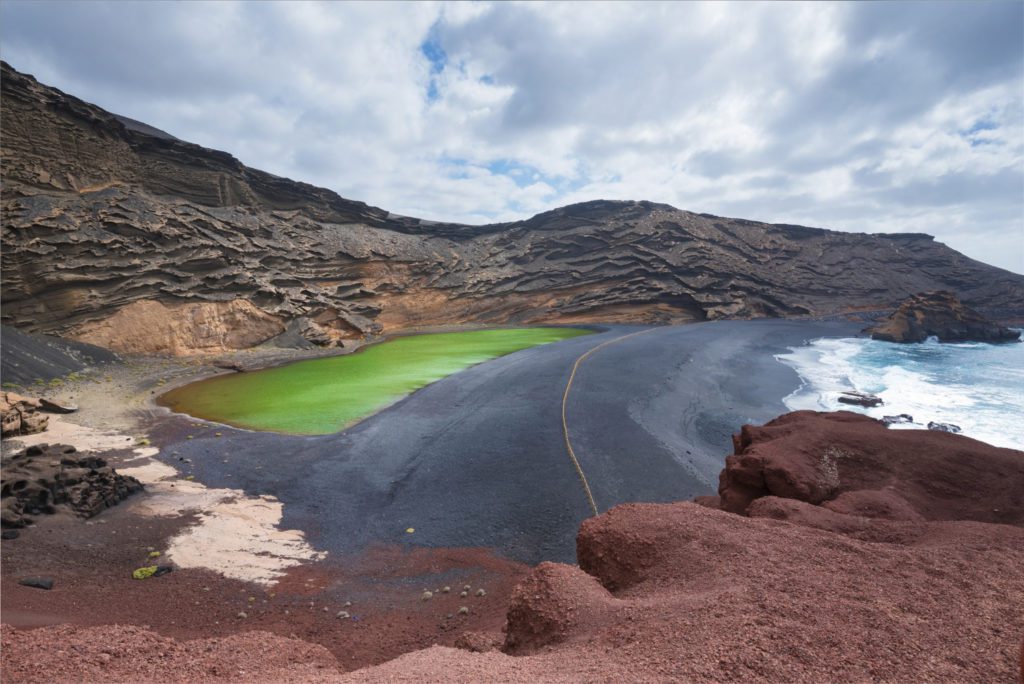
La Graciosa National Park
North of Lanzarote, the island of La Graciosa, with its 27 km², holds the position of being the largest among those that make up the Chinijo Archipelago, which includes the islets of Alegranza, Montaña Clara and the Roques del Este and del Oeste. The island of La Graciosa is one of the must-see places in Lanzarote during your trip.
All these formations make up the Chinijo Archipelago Maritime-Terrestrial Natural Park, which was the first to be designated by the Canary Islands Government.which was the first to be designated by the Government of the Canary Islands. The waters surrounding the island are under the protection of the Marine Reserve Isla Graciosa and Islotes del Norte de Lanzarote.
Wild nature in La Graciosa
The terrestrial environment of La Graciosa is distinguished by its striking landscapes of volcanic origin, characterized by dunes and sandy areas, and its extraordinary biodiversity, which includes numerous species of endemic flora.
In addition, the island plays a crucial role as a stopover point for several protected migratory birds and as a breeding habitat for some endangered species.
Being the only inhabited island of the Archipelago, La Graciosa has two population centers, La Caleta del Sebo and Pedro Barba, the first being the only one inhabited throughout the year, with a population of approximately 627 inhabitants, mostly dedicated to fishing.
As for the marine environment, the mild temperatures of the surrounding waters offer conditions conducive to harboring an extraordinary diversity of species of both fauna and flora, distributed in various coastal and bottom habitats.
With the exception of the urban centers of La Caleta del Sebo and Pedro Barba, which are owned by the State, the entire island of La Graciosa was assigned to the National Parks Autonomous Organization according to the Ministerial Order of October 10, 2002, formalizing the handover and reception on January 20, 2003.
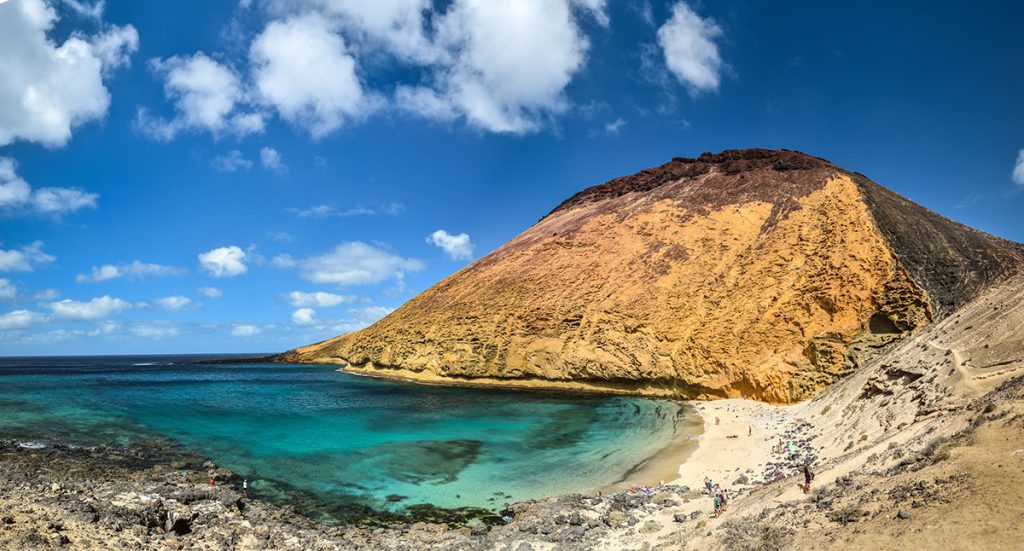
Beaches in La Graciosa
Less known than its big sisters, La Graciosa is an island of 29 square kilometers located northwest of Lanzarote. It is part of the Natural Park of the Chinijo Archipelago along with four islets.
Most of its more than 700 inhabitants live in one of the two population centers of the island, Caleta de Sebo. This haven away from the hustle and bustle and without roads is the perfect destination to disconnect and enjoy days of calm and relaxation, surrounded by an unspoiled landscape with wonderful beaches often lonely. The only ways to get around the island are walking, cycling or by 4×4 cab.
Here are some beaches not to be missed in La Graciosa:
La Francesa Beach
Located in the south of the island, its fine white sand and calm turquoise waters make it a favorite. It also offers wonderful views of the Riscos de Famara in Lanzarote.
La Cocina Beach
Near La Francesa beach, this beach sheltered from the narrow arm of the sea known as El Río is perfect for a relaxing swim in crystal clear waters. It stretches at the foot of the ancient Montaña Amarilla volcano, creating a magical landscape.
Las Conchas Beach
In the northwest, it is one of the most beautiful beaches of La Graciosa. Surrounded by the unique environment and with privileged views of the islet of Montaña Clara, this white sand beach offers a breathtaking scenery.
Amber Beach
Also known as Lambra beach, it is located near Pedro Barba, the other inhabited nucleus. With crystalline waters, white sand dunes and volcanic rocks, it is a wild and little frequented place.
La Laja Beach
Located in the town of Caleta de Sebo, next to the port of arrival, it is a cozy beach of golden sand and calm waters, ideal for families. It also offers the opportunity to enjoy fresh fish in nearby restaurants.
El Salado Beach
A little more than 15 minutes walk from Caleta de Sebo, is a wonderful beach of white sand and calm waters, surrounded by small dunes and overlooking the Montaña Amarilla and other impressive volcanoes. Near this beach is the only camping area allowed on the island.
La Graciosa offers a natural paradise where peace and magic combine in every corner, providing the opportunity to disconnect and immerse yourself in the beauty of its beaches.
What to do in Lanzarote
If visiting the island is a pleasure for the senses for the multitude of things to see in Lanzarote, now it’s time to talk about everything you can do there.
Here the choice of activities to do in Lanzarote is also almost inexhaustible. Let’s make a tour of the most famous and surprising plans of the island.
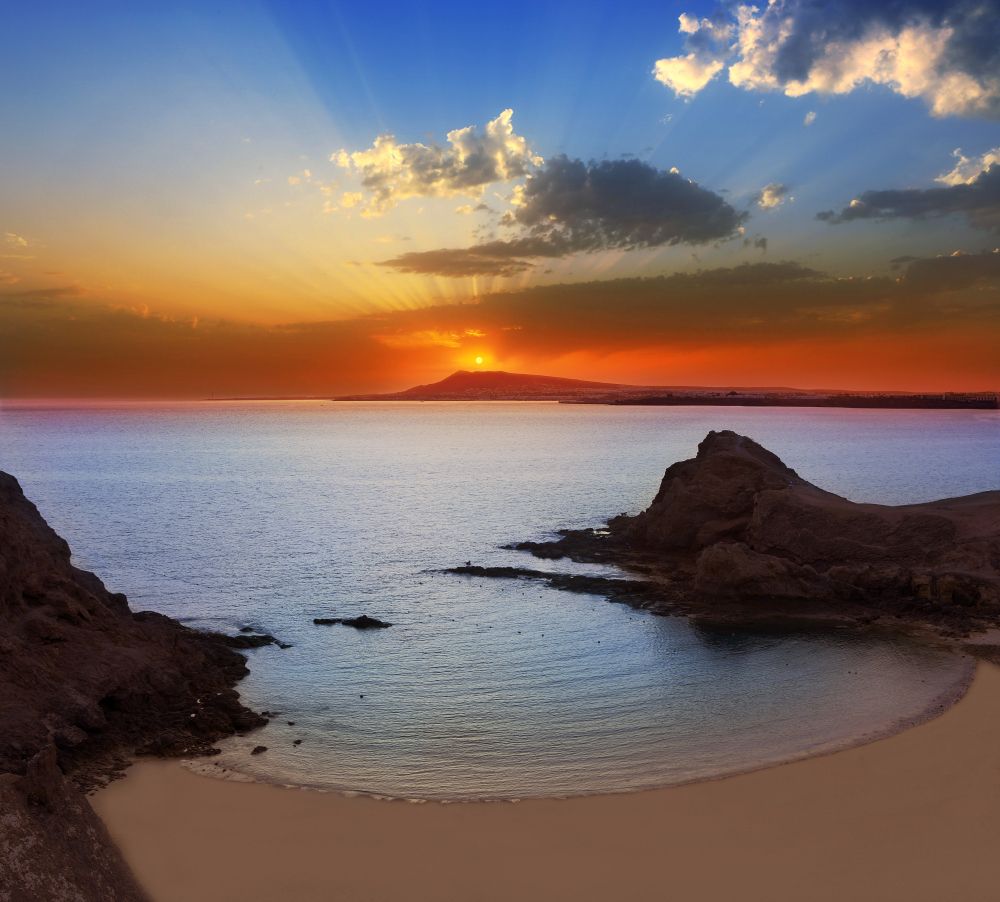
The beaches of Lanzarote
On the island of Lanzarote, the experience of visiting its beaches becomes a transcendental event. Despite being a tourist destination, the island has preserved its naturalness, highlighting its landscape as its main attraction. An ecstatic song to the natural elements: earth, air, water and fire.
Lanzarote’s coastline unfolds with small coves and surprising beaches, shaped by volcanic eruptions. A minimalist scenery where the ocher trim the horizon and the tones of the Atlantic become their own shades.
Declared Biosphere Reservethe beaches of Lanzarote guarantee an authentic connection with nature.
Papagayo beach and Rubicon coves
Crossing the lunar plain of the Rubicon coast, a beach galaxy is revealed with six wild beaches of sensual golden chime.
Here stands out the Papagayo Beach forming a perfect curve between two morrones, open to a bay of calm waters with green and blue bottoms. Preferred by divers, it offers views of the islet of Lobos and the dunes of Corralejo on the horizon.
La Caleta del Congrio
On the Papagayo coast itself, Cala Escondida presents itself as a nudist oasis next to an impressive volcanic rock wall. Soft sand, turquoise blue sea and the feeling of being away from civilization make this place a natural paradise.
Risco de Famara, a corner for surfers
With impressive vertical walls, the Risco de Famara is perceived as the backbone that plunges into the Atlantic. Not suitable for quiet bathing, this beach is an icon for surfers and windsurfers, offering a panoramic view worth exploring.
The Clicos Pond, an ancient volcanic crater
In Charco de los Clicos, nature creates a surreal picture with olive green, black, rusty colors and turquoise of the sea. This ancient volcano crater separated from the sea by a beach of sand and black pebbles is a unique visual experience.
La Caleta del Mero, a beach between dunes
Near Haría, Caleta del Mero stands out for its white sand dunes and turquoise waters, creating a rustic and little-traveled landscape that seems out of this world.
Risco Beach
On the coast of Yé, Playa del Risco, sheltered by the spectacular cliff of Famara, offers beauty along with the difficulty of access. A one-hour route with complicated sections offers an experience in solitude and a spectacular view.
Playa Grande, an urban beach
In Puerto del Carmen, Playa Grande is presented as an urban and comfortable option to enjoy the sun and the beach. With services and a pleasant avenue, it is a perfect place to relax without much effort.
Playa de las Conchas and its panoramic views
In La Graciosa, Las Conchas Beach stands out for its purity and toasted and white tones, thanks to the Sahara chime corridor. With impressive contrasts and views of Alegranza Island, it offers a sublime experience.
Playa Francesa, nature in its purest form
Along with Las Conchas and La Cocina, Playa Francesa is famous in La Graciosa. Accessible after a short walk, it offers a lagoon of calm waters with spectacular views thanks to the Punta de la Herradura that protects it.
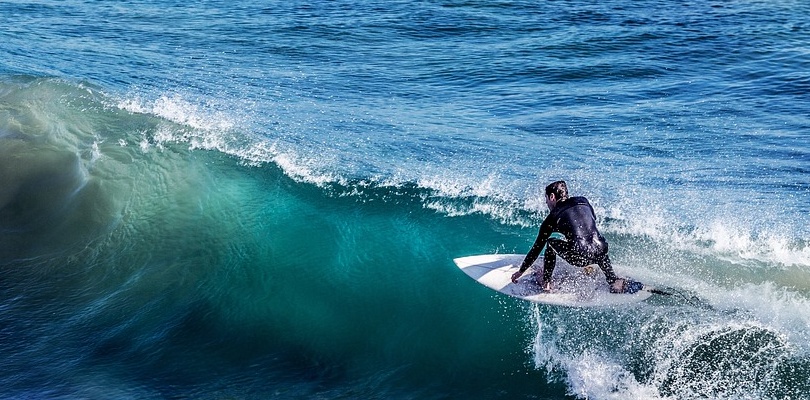
Surfing in Lanzarote
Known as the Hawaii of the Atlantic, Lanzarote goes beyond being an island full of energy. Volcanic rocks, paradisiacal beaches, crystal clear waters and underwater landscapes add to its offer.
All this, together with an everlasting spring, make it one of the most important best destinations for an unforgettable surf trip. Lanzarote attracts surf lovers to world level thanks to its temperate climate, ideal winds, diverse spots for all levels and high quality waves, making it ideal for surfing at any time of the year.
Lanzarote’ s beaches offer waves for all levels. Famara beach, considered the best to learn in the Canary Islands, is perfect for beginners. On the other hand, more experienced surfers can opt for La Santa or El Quemao, beaches with challenging waves, some of the biggest in Europe.
Famara Beach: Lanzarote’s surfing paradise
Famara beach, located next to Caleta de Famara, stretches for more than 5 km and is the perfect place for surfers visiting the island. With golden sand and waves breaking left and right, Famara is a favorite of surfers.
The main surf schools are located here, offering equipment and lessons for beginners. There are also surf stores surfboards and wetsuits rental services. Famara has lifeguard and first aid services.
Right here you will find our Lanzarote Surf School where you can learn to surf with experienced instructors who have been passionate about surfing and our wonderful island of Lanzarote all their lives.
Surf Spots in Famara
Famara offers several spots, both left and right, with fast waves and tubes. The best known spots include:
Beach Center
Considered the safest area for beginners with a sandy bottom, it is ideal for surf lessons and within walking distance from town.
Famara Pier
A well-known and spectacular spot, but not suitable for beginners. Requires a good level of skill due to the rocky bottom.
El Codito
A mixed spot of rock and sand, located at the entrance of Famara. It has some difficulty due to the rocks, but it is ideal when Famara beach is overgrown.
San Juan
Suitable only for experienced surfers, with fast and powerful waves on rock bottom. It is reached by taking the dirt track at the end of the village.
La Santa: surfing at any time
In the port of La Santa, you will find an ideal spot for surfing all year round. The left side of La Santa is sought after by the most experienced surfers.
This fishing village, located on the northwest coast of Lanzarote, offers a beach made up of sand and rock 130 meters long.
Surf in Lanzarote for beginners
Lanzarote is famous for being the ideal place to learn surfing, with a wide range of courses available throughout the year. Affordable prices complement the proposal, making it an attractive option in the European area.
Outdoor activities in Lanzarote

Enjoy a diverse range of water activities inthe crystal clear waters of Lanzarote, an island blessed with dozens of kilometers of coastline with a multitude of plans for outdoor activities.
Buggie routes
Embark on exciting routes aboard buggies, small off-road cars that will take you to the most spectacular corners of the island.
Bicycle Routes
Cycling is a star activity in Lanzarote, with mountain and road routes that satisfy both amateurs and professionals. Rent or bring your own bike and discover unique landscapes guided by the well-marked road network.
Motorcycle Routes
The freedom of motorcycles allows you to explore the island in a unique way. Although the offer is not as wide as that of cars or bicycles, there are places that offer motorcycle rentals of different types.
Hiking
Explore Lanzarote on foot through its extensive network of well-marked trails. Walk independently or join specialized guides to discover the diversity of the island’s landscapes.
Camel ride
Experience the tradition of Lanzarote with a camel ride through the Timanfaya National Park. A unique tour to enjoy the scenery at the quiet pace of these animals.
Karting
If you are looking for speed, the karting circuits on the island will give you the perfect dose of adrenaline.
Theme Parks
Lanzarote has theme parks such as Rancho Texaswhich combines attractions with animals and shows, and the Aquapark in Costa Teguise, ideal to enjoy with the family. In addition, in Playa Blanca, there is the Aqualava park.
Photography
Lanzarote’s photogenic beauty is undeniable. From breathtaking skies to lunar landscapes, the island offers a variety of scenery ideal for photography lovers. Embark on guided tours or capture your memories with your own camera on this island of volcanoes.
Paragliding
Lanzarote, known for its constant winds, offers unique opportunities for paragliding. The experience is enhanced with tandem flights offered by specialized professionals.
Astronomy
The night skies of Lanzarote, with its low light pollution, make the island a privileged place for astronomical observation. Explore the firmament on your own or join specialized guides to admire the Milky Way and the stars in all their splendor.
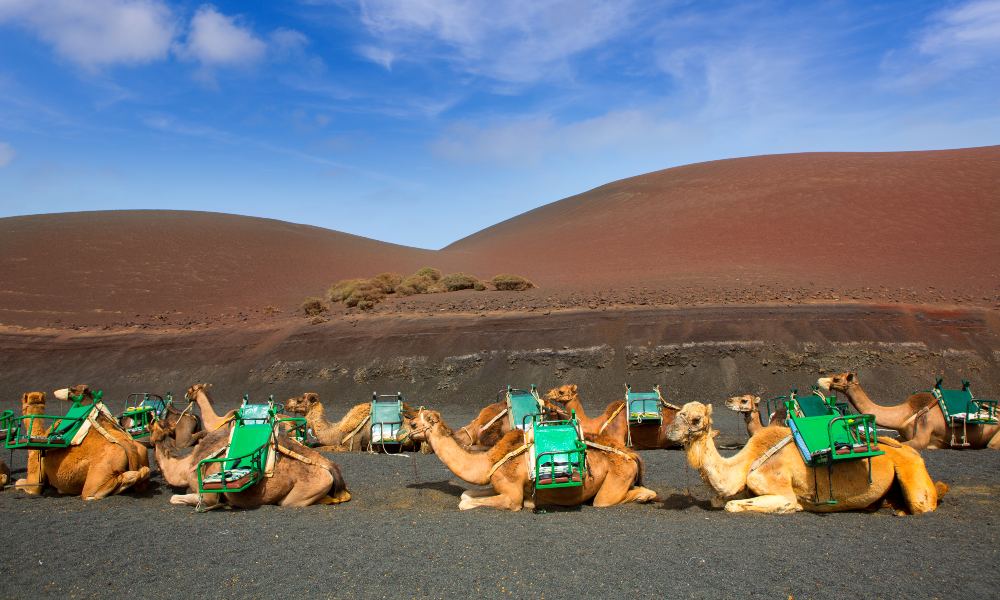
Water activities to enjoy in Lanzarote
If Lanzarote is characterized by something is for its beaches and its rich marine environment. So it is inevitable that the offer of water activities in Lanzarote is huge.
Discover below the main activities to do in Lanzarote to make the most of the aquatic environment of this Atlantic jewel. Here is just a selection of the most common ones.
Windsurf
Costa Teguise stands out as the epicenter of windsurfing in Lanzarote. With Playa de las Cucharas as a backdrop, the area is home to schools and stores offering equipment rental. In addition, Costa Teguise has become the venue for the European Freestyle Championship, attracting professionals and amateurs from all over the continent.
Diving
Explore the underwater treasures of Lanzarote, where the seabed reveals its splendor. Whether you are a beginner or an experienced diver, the numerous diving schools on the island guarantee unforgettable dives.
And you can always combine the experience of diving with learning to surf in a combo of sport and adventure ideal for a week in Lanzarote.
Boat Excursions
If you love the sea, a boat trip in Lanzarote becomes an enchanting and relaxing experience. From excursions to other islands like Fuerteventura or La Graciosa, to whale watching or just relaxing and enjoying the sea.
Rent boats in ports such as Marina Lanzarote or Puerto Calero to tailor the experience to your desires.
Water Attractions
The exciting water attractions also have a place in Lanzarote. In Puerto del Carmen, you can enjoy activities such as JetSky, Paragliding in the water, Banana boat, Flyboard and Jetboat, designed to provide adrenaline, speed and fun.
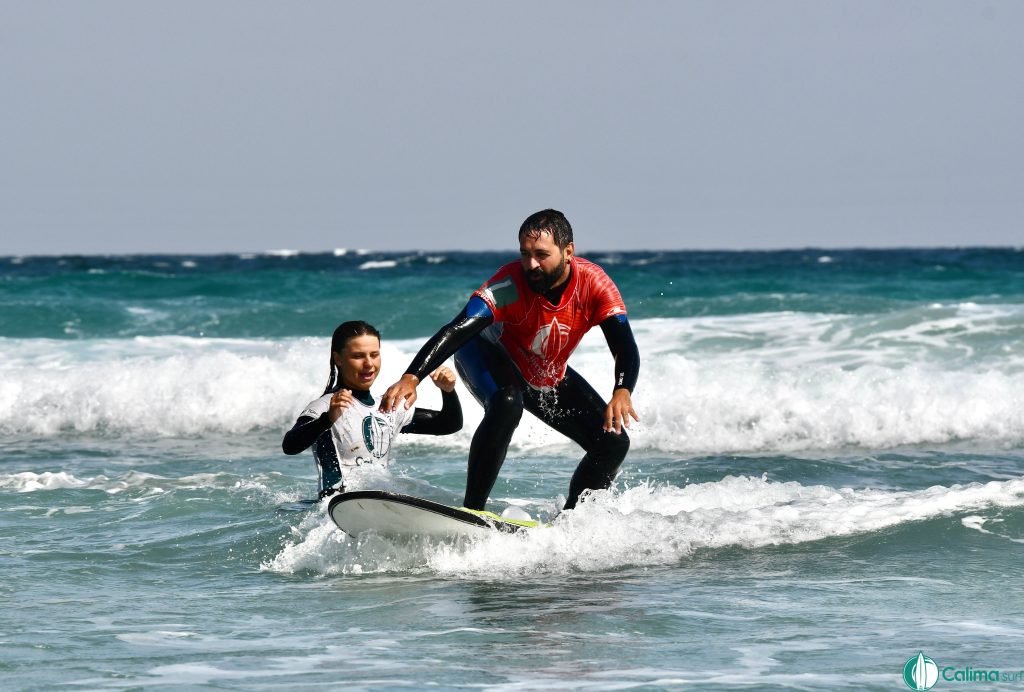
Surf
Lanzarote stands as the crown jewel of water sports, and surfing is its outstanding reference. With notable spots such as El Quemao in La Santa, reserved for the most experienced, and the extensive beach of Famara, ideal for learners and enthusiasts.
The presence of numerous surf schools underlines the popularity of the island as a destination to learn and enjoy this sport, in total harmony with nature.
Stand Up Paddle (SUP)
The versatility of SUP allows everyone to enjoy the waters of Lanzarote. Whether for a quiet ride in the open sea or for paddling waves, this activity adapts to different skill levels.
You can explore the Arrecife marina from a unique perspective or choose from several areas on the island to practice SUP, ensuring a unique experience in contact with the environment.
Kayak
A kayak tour in Lanzarote, whether solo, accompanied or in a group, offers an excellent way to disconnect and connect with nature. Lanzarote offers the opportunity to rent kayaks to explore its coasts on your own or join guided tours to maximize the experience.
Kitesurf
The characteristic winds of Lanzarote make kitesurfing an outstanding activity. From the beach of Famara to the area of Guacimeta, the practice of this exciting sport finds its place on the island.
Numerous schools and rental stores provide access to the necessary equipment, either through professional courses or rental for those with experience.
You can also plan an adventure for those who are very passionate about surf and wind by learning to surf and kitesurf in the same organized camp with accommodation and many hours of lessons with the best local experts.
What to eat in Lanzarote: Its Gastronomy
Lanzarote’s climatic and geographical environment has had a significant impact on the development of a specialized agriculture, focused on products adapted to the island’s conditions and complemented with seafood that enriches its cuisine.
Although simple and stripped down, Lanzarote’s gastronomy reflects the character of the island and its people, prioritizing the optimal use of natural resources.
The essence of its dishes is based on the quality of local products from land and sea.
The tourist boom in recent years has led to a remarkable growth in the culinary scene of Lanzarote, without implying the loss of its traditional values.
In this process, foreign dishes have been integrated, such as garbanzas compuestas, stews and pickled fish, which have taken root in the popular cuisine.
These dishes coexist with classic elements from the Canary Islands or Lanzarote, such as gofio, a toasted corn flour that maintains its relevance in the diet, just as it did in the pre-Hispanic population.
Typical dishes of Lanzarote
Lanzarote’s cuisine offers a varied range of dishes, many of which are shared with the rest of the Canary Islands. Adapted to the specific conditions of the island, characterized by the scarcity of water and the presence of tasty products, these dishes are enjoyed in exceptional natural surroundings.

Gofio
Gofio has been, throughout history, the most outstanding Canary Island food. Consumed throughout the Canary Islands since aboriginal times, gofio is a toasted cereal flour that can be enjoyed in various meals, either accompanied by milk, honey, sugar or wine, or added to a fish broth.
With a high nutritional value, gofio has been essential in the feeding of infants and growing children. Its artisanal production and dietary properties have led to its recognition as a “Quality Food” by the European Union.
Starters
From gueldes, jareas and limpets to marinated tuna and cheese, Lanzarote presents a series of starters that take advantage of local products in a masterful way. Pejines, small sardines or sun-dried anchovies, are an example of the local culinary tradition.
Papas arrugadas, prepared with small or medium-sized potatoes, water and plenty of salt, are essential in several dishes and serve as an accompaniment to others. Mojos, either red or picón with canary peppers, or green with coriander, enhance the flavor of the potatoes or are dipped in them.
Main Dishes
Food in the Canary Islands follows the Mediterranean tradition, where lunch is the main meal. In Lanzarote, traditional dishes such as caldo de pescado, sancocho, pescado cebollado and others show the important presence of the sea in the local cuisine.
Sancocho, made with wreckfish, potatoes and sweet potatoes, accompanied by mojos and gofio, stands out as one of the most significant dishes of the Canary Islands. The vieja, a fish with a mouth shaped like a parrot’s beak, is presented stewed or on its back, adding varied colors to the culinary offer.
Livestock also has its place, demonstrated in dishes such as rancho canario or goat meat or rabbits in sauce, which show the skill in their preparation.
Desserts
Lanzarote has deep-rooted desserts on the island, such as peanut bread and roscos de alma, which are mixed with more common options in the Canary Islands, such as frangollo or bienmesabe. These desserts are linked to festivities, especially Carnival and Christmas, and include roscos, torrijas and truchas.
Typical Products
Despite the challenging climatic conditions, Lanzarote produces a wide variety of products. From vegetables such as onions, tomatoes, potatoes, sweet potatoes and watermelons to legumes such as lentils and cereals such as wheat, barley, rye and millet (corn), the island demonstrates its ability to grow quality food.
Meat, mainly goat, is very popular, and fish, prepared in various ways, occupy a central place in Lanzarote’s gastronomy.
Lanzarote cheeses, made mainly with raw goat’s milk, represent a delicious tradition that is diversified with options such as smoked cheeses or covered with gofio or paprika.
The diversity of Lanzarote’s products reflects the island’s ability to grow and create high quality food, despite climatic challenges, and contributes to the richness and authenticity of its cuisine.
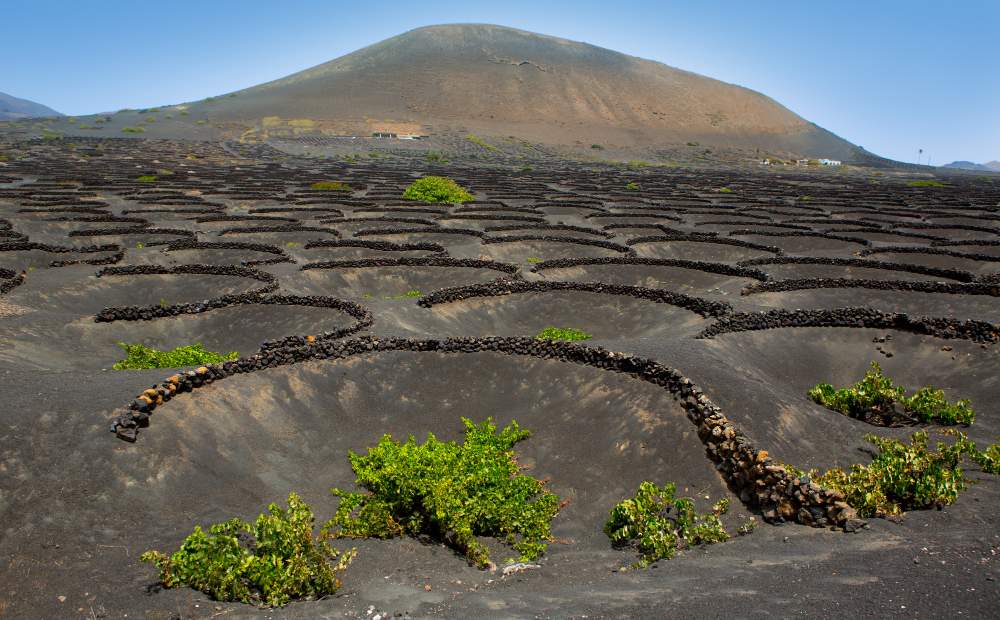
The wines of Lanzarote
Lanzarote wine, distilled from volcanic energy, stands as one of the greatest culinary delights of the island, and the majesty of the cultivation of the vine, especially in the region of La Geria, adds a unique spectacle when savoring a delicious meal. This landscape, protected for its outstanding cultural and aesthetic value, is under the protection of the law.
The island of Lanzarote has a Regulatory Council for the Denomination of Origin of its wines, whose function is to safeguard quality by supervising the cultivation areas and the production of the exquisite wines.
With an exceptional palate, Malvasia is a brilliant experience, with a toasted to amber color that radiates lively sparkles. Its almondy flavor, with fine, balanced and intense aromas, and hints of acidity in some cases, make it a voluptuous and full-bodied choice.
Historical personalities, such as the enlightened monarch Charles III, Walter Scott, Goldoni and William Shakespeare himself, have extolled the virtues of Malvasia wine throughout history.
In addition, the varieties Diego blanco, in its dry and semi-sweet versions, as well as rosé wines, whose production has evolved towards early harvests, resulting in young, fruity wines with lower alcohol content, stand out.
Harvesting in Lanzarote begins in late July and is a manual labor due to the topography of the terrain. Farmers harvest the grapes early in the morning, eliminating those that are deteriorated, with the aim of preserving the raw material and obtaining wines of excellent quality.
Designation of Origin Lanzarote
The Denomination of Origin Wines of Lanzarote was established in 1993. The Regulatory Council of the Designation of Origin Lanzarote is responsible for certifying the origin and guaranteeing the quality of the wines of the island. The back label granted by the Regulatory Council is an unequivocal guarantee of quality and certification of a unique typicity in the world.
The Designation of Origin Lanzarote covers the whole island, but there are three main producing areas:
La Geria
Located between the municipalities of Yaiza and Tías, it is a unique volcanic site in the vicinity of the Timanfaya National Park. This method of cultivation, unique in the world, uses the natural sanding resulting from the eruptions.
Masdache
In the center of the island and north of La Geria, it is the most extensive cultivation area.
Ye-Lajares
In the north of the island, between the municipalities of Haría and Teguise, it is a wine-growing area with a lower yield per hectare, unique in the world due to its early harvest.
The grape varieties grown in almost 2000 hectares of vineyards, spread over more than 7500 plots, include:
- Whites: Malvasía, Breval, Burrablanca, Diego, Moscatel, Listán and Pedro Ximénez.
- Black: Negramoll and Listán negro.
These varieties produce very expressive dry white wines , semi-sweet, fruity and unctuous, complex sweet wines on the nose, fresh rosés and lively and fresh reds, as well as sparkling wines.
Lanzarote’ s rich winemaking tradition is manifested in a wide variety of wines that capture the unique essence of the island, where the volcanic soil and the art of winemaking intertwine to create unparalleled sensory experiences.
The Work of César Manrique
We have already talked about the work of César Manrique in Lanzarote but it is worth remembering it again. César Manrique left a unique artistic mark on the island of Lanzarote that is worth visiting and enjoying.
Although he maintained his allegiance to the informalist tradition in painting, his sculptures and objects, conceived mainly for his spatial interventions, explored the currents of pop art, kinetic art and new sculpture.
His work in Lanzarote developed at the end of the sixties when he returned to the island. Here he found the right environment to expand his artistic practice to new dimensions. He was able to give concrete form to his new aesthetic ideology, devoting much of his creativity to interventions in space.
These works became the most palpable manifestation of his artistic and ethical vision, fusing nature and art in what he called art-nature/nature-art.
Among Manrique’s notable contributions were the Casa Museo del Campesinothe Castillo de San José and the El Diablo Restaurant in Timanfaya. These public works reflect not only the creator’s artistic skill, but also his active commitment to the preservation and promotion of Lanzarote’s natural and cultural environment.

El Campesino House Museum
Located in the geographical heart of Lanzarote, in the municipality of San Bartolomé, the Casa-Museo del Campesino represents César Manrique’s appreciation for the hard work of Lanzarote’s farmers, defying the adverse conditions of the territory.
This house-museum offers a fascinating journey through the architecture, agriculture, crafts and traditional gastronomy of the region. It is complemented by the Monument to Fertility, an avant-garde work in which César Manrique wanted to express his particular tribute to the fertility of the environment.
César Manrique Foundation
Located in the north of Lanzarote, in the charming little village of Tahiche, the César Manrique Foundation occupies 3,000 square meters of land, including the artist’s former residence and one of his studios. With a unique combination of art, culture and livability all in one, the César Manrique Foundation is the perfect stop for art lovers, curious thinkers and anyone in search of natural beauty.
Learn about the fascinating history, artistic architecture and environmental design of the César Manrique Foundation. It is a true testament to his creative mind, a great example of how man and nature can coexist beautifully. You will leave full of inspiration and beautiful memories.
César Manrique House Museum
The Casa Museo César Manrique is an architectural marvel in its own right. Designed by the artist himself, it is an impressive example of Manrique’s unique style. Inside, visitors have the opportunity to explore the various galleries of the museum, as well as the artist’s former residence in Haría.
The museum offers the opportunity to see some of Manrique’s most important works of art, as well as to enjoy the stunning natural surroundings. So, whether you are an inveterate art lover or just want to soak up the unique artistic spirit of Lanzarote, the Casa Museo César Manrique is an experience not to be missed.
The Chinijo Archipelago
It is a group of islands located to the north of Lanzarote, close to the southern coast of Morocco. Despite their small size, these islands have very important protected areas, such as the Integral Natural Reserve of Los Islotes and the Natural Park of the Chinijo Archipelago, composed of three islands and two islets.
La Graciosa Island
The largest and only inhabited island of the Chinijo Archipelago, La Graciosa, covers 27 km² and is separated from Lanzarote by the Rio Strait. With about 660 inhabitants distributed between Caleta de Sebo, the capital, and Pedro Barba, it has beaches of remarkable beauty such as La Concha and La Francesa.
Alegranza
This island, the northernmost of the Canary Archipelago, is the second largest of Chinijo. With a maximum altitude of 298 m in La Caldera, Alegranza stands out for the abundance of fish in its waters, which makes it a biodiverse habitat, especially for birds such as the Cory’s Shearwater and Ospreys.
Clear Mountain
The smallest island of the archipelago, Montaña Clara, with 2.7 km² of extension, serves as a refuge for fauna, highlighting its importance for marine birds such as the Leonor Falcon, the Cory’s Shearwater and the Paiños. Its name comes from the light tones that characterize its entire surface.
Roque del Este
Located 12 km east of Lanzarote, Roque del Este is the easternmost point of the Canary Archipelago . With volcanic origin, it stands out for its unique relief, including the naturally carved rock called El Campanario, and the presence of a subspecies of lizard typical of the place.
Roque del Oeste
The smallest islet, known as “Roquete” or “Roque del Infierno”, is an almost inaccessible stone monolith that emerged from a volcanic cone dismantled by erosion. Although of reduced dimensions, its inhospitable aspect and its black color give it an outstanding singularity.
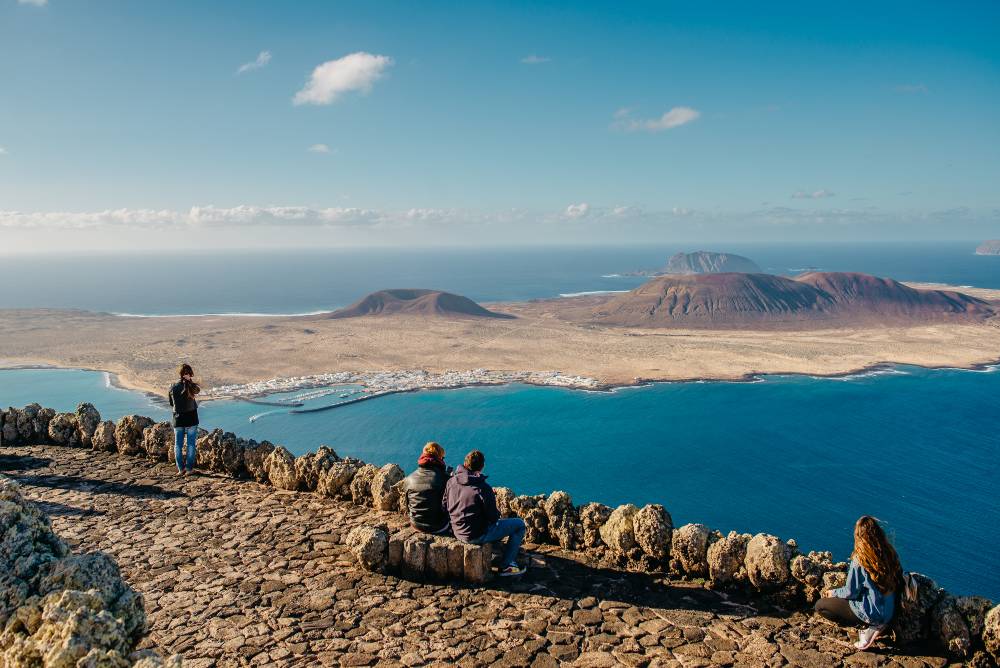
Volcanic landscapes and lava caves
To explore the astonishing beauty of Lanzarote’s volcanic landscapes the perfect place is to take an excursion to Timanfaya, which we have already told you about.
This trip immerses you in some of the region’s most striking landscapes, formed by volcanic eruptions that left their mark centuries ago.
Timanfaya stands out as the most emblematic volcanic area of Lanzarote, a place not to be missed. Here, you will have the opportunity to admire up close the lava fields, craters and almost lunar landscapes sculpted by volcanic activity.
You will also be able to enjoy geothermal explosions when the water meets the heat of the subsoil, offering you a unique and impressive experience.
Take advantage of this same excursion to visit the Timanfaya National Park for a camel ride between lava dunes. A great adventure that will allow you to enjoy the landscape in a different way.
The proximity of the Jameos del Agua makes it more than advisable that you take advantage of it to see them closely. A landscape that transforms caves and volcanic tunnels into an impressive space. You will find a subway lake, lush gardens and a magnificent natural pool, creating an environment of incomparable beauty.
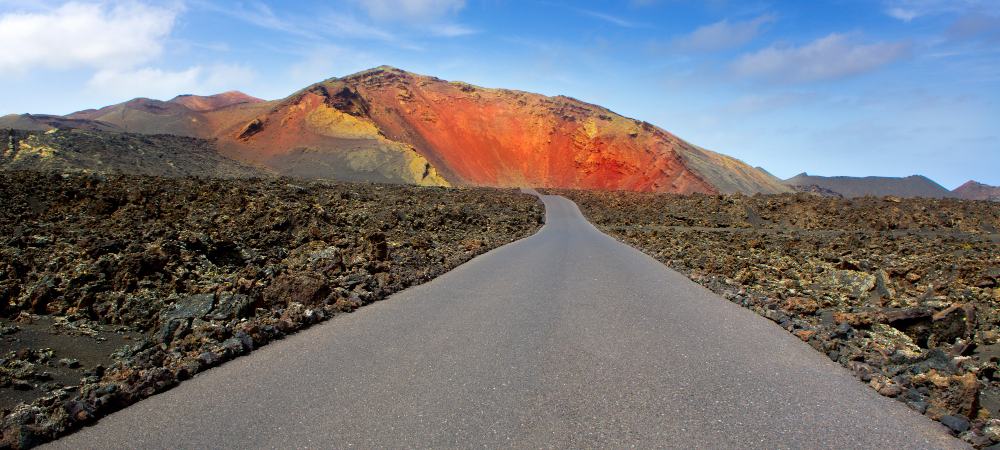
Visit charming places in Lanzarote
Before finishing we can not overlook two charming places in Lanzarote that you can not miss: Haría and Yaiza.
Haría
The charming municipality of Haría, located in the north of Lanzarote, is distinguished for enjoying a special microclimate that turns its lands into the most exuberant and greenest of the island. In this region, most of the autochthonous flora is concentrated, including endemic species unique in the world.
It is also known as the Valley of the Thousand Palmsthanks to the abundance of this tree in the area. In addition to tuneras and cactus in abundance.
Located in the old alley parallel to the ravine of Elvira Sánchez, the Casa del Palmeral was the last residence of César Manrique, of which we spoke before .
The artist found in Haría the peace and connection with nature he was looking for. Since 2013, the house has opened its doors as a House-Museum César Manrique.
You can‘t miss the Mirador de Haría, also known as Mirador de Malpaso, which offers a panoramic view of the municipality and the entire valley.
Near Haría, on the road to Órzola, is the Cueva de Los Verdes, a subway gallery that is part of one of the largest volcanic tubes in the world, the result of the eruptions of the volcano La Corona.
Yaiza
The town of Yaiza is located in the south of the island and has the honor of being the first place of conquest and the first European enclave in the Canary archipelago. It shares with Tinajo the other significant portion of the Timanfaya National Park.
The core of the village is located on the edge of the area buried by the volcanic eruptions of 1730 and 1736.
This village, recognized as one of the best preserved of the Canary archipelago, has been honored with several awards for its beauty. This can be appreciated when walking through its streets where the houses, extremely well cared for and decorated with a variety of plants and flowers, create a charming environment.
Yaiza stands out among the villages of the island for its landscape care and respect for traditional architecture.
Nightlife in Lanzarote
To finish this extensive guide which aims to let you know what to see in Lanzarote and everything you can do on the island we are going to give you some information so you can also enjoy the nightlife of Lanzarote.
Nightlife in Lanzarote is very rich and varied and offers options for all tastes.
Dance halls, discos and pubs can be found mostly in the capital Arrecife and the tourist resorts of Puerto del Carmen, Playa Blanca and Costa Teguise.
Depending on your musical preferences and the ambience you like best, you will find all kinds of venues that are usually open until three in the morning.
In Puerto del Carmen, renowned for its lively nightlife, the promenade around Playa Grande beach is the epicenter of activity, with numerous bars and clubs.
Playa Blanca, more relaxed but equally attractive, offers select bars and clubs on the waterfront and in the harbor.
Costa Teguise, with a more familiar atmosphere, presents options in Avenida de Jabillo and Pueblo Marinero.
Teguise, the former capital, has gained popularity for enjoying Sunday evenings after the flea market, with a variety of live music concerts.
Arrecife also has a wide range of bars with varied music and an authentic local atmosphere.
The island also has outstanding festivals such as Arrecife En Vivo and Jameos Music Festival to highlight two of the most famous.
** Photographs of Lunamarina used through Freepik license.
Related articles

How to measure the height of a wave
BOOK NOW How to measure the height of a wave You probably want to know how to measure the height

Types of waves and parts of a wave, what you need to know
BOOK NOW Types of waves and parts of a wave, what you need to know If you want to be

Surf brands that every surfer should know about
BOOK NOW Surf brands that every surfer should know about It is advisable to know all the best surf brands,
